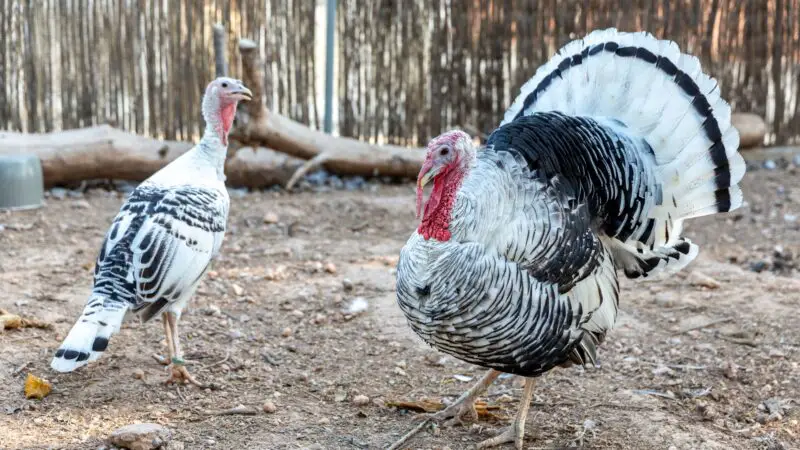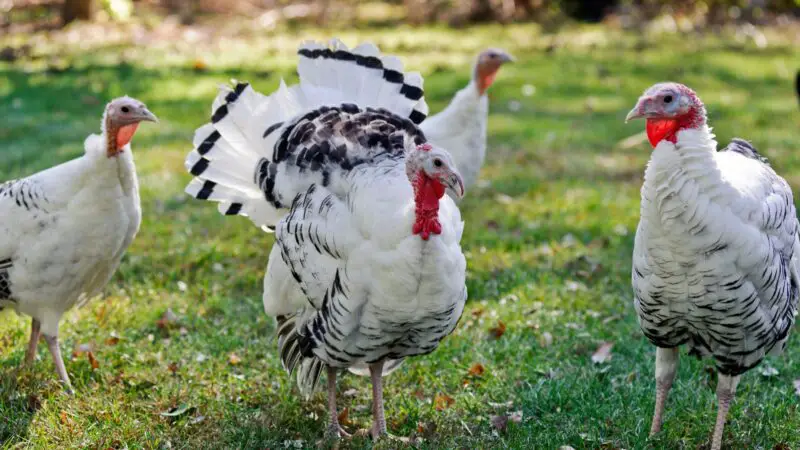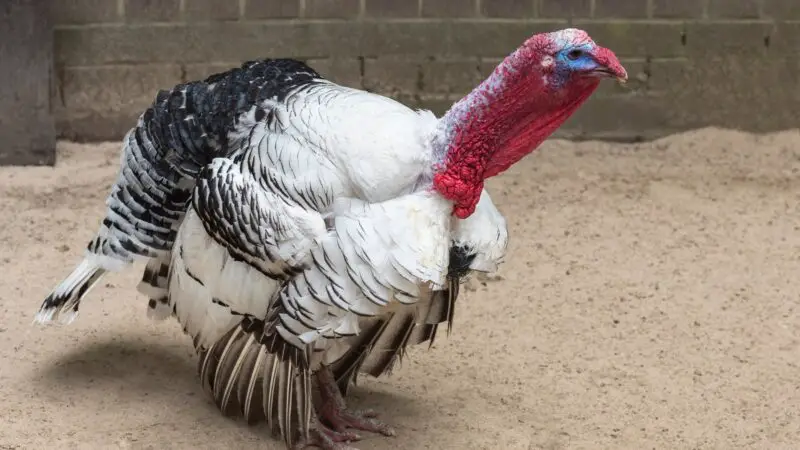Heritage turkeys are often raised for their egg-producing abilities, lean meat quality, and great personality. This makes them good enough pets,
They also raised for striking plumages, which makes them excellent participants for poultry exhibitions. Some varieties are rare and low in population, such as the Royal Palm turkey.
Royal Palm turkeys are a variety of turkey breeds that have been introduced in the United States in the 1920s. They have a distinct black-and-white plumage pattern, which makes them great exhibition birds.
When hand raised and coddled well, they can grow to become friendly birds. Compared to other varieties, they are great flyers.
This article discusses Royal Palm turkeys, their physical attributes, distinctive characteristics, history and place of origin, personality, and other interesting information. Read further for more!
The History of Royal Palm Turkeys

This heritage turkey variety has been introduced in Florida by the 1920s, but it is believed that they might have been a crossbreed between or have descended from European breeds due to the similar characteristics they share with the Crollwitzer, English Pied, and Ronquieres turkeys, which were breeds known since the 18th century.
Since its introduction, further selective breeding was performed to maintain the consistency of color and other physical characteristics. However, it wasn’t until 1971 that the Royal Palm turkey was formally recognized by the American Poultry Association to be fitting to its standard of perfection. Today, the Royal Palm turkey is also referred to as the Pied or Crollweitz turkey.
In a 2005 study, researchers proved that the Royal Palm turkey is a breed and not merely a heritage turkey variety as proven by its genetic and molecular composition compared to other varieties. This was further backed up by a 2019 study, as additional evidence was discovered.
Are Royal Palm Turkeys Rare?
Royal Palm turkeys are rare. Most, if not all, heritage turkeys represent only a minority in the total population of turkeys.
They have only recently gained popularity among commercial growers. Additionally, the American Livestock Breeds Conservancy categorizes the Royal Palm turkeys as threatened.
Royal Palm Turkey Identification
What Do Royal Palm Turkeys Look Like?
Royal Palm turkeys have a distinct plumage pattern. Although they are white overall, they have sharply contrasting black feathers, specifically black-lined breast feathers, black-rimmed tail, black back and bear, and white neck feathers. They also have red wattles, bluish-white or red heads, light brown eyes, deep pink toes and shanks, and a light horn beak.
How Long Does a Royal Palm Turkey Live?
The normal lifespan of a royal palm turkey is 1 to 2 years in captivity. This is significantly shorter than any domesticated turkey, which usually has a lifespan of 10 or more years.
How Big Do Royal Palm Turkeys Grow?
Royal Palm turkeys are smaller than other turkey varieties, with a length of 100 to 124 centimeters.
Are Royal Palm Turkeys a Heavy Breed?
Royal Palm turkeys are not a heavy breed. Jakes, or young male turkeys, have an average weight of 7.3 kilograms, while jennies, or young female turkeys, weigh about 4.5 kilograms. Adult toms also referred to as gobblers, weigh 9 kilograms, while adult hens weigh 5.5 kilograms.
Royal Palm Turkey Wingspan
The wingspan of Royal Palm turkeys has yet to be discovered. However, since small-sized domesticated turkeys have a wingspan of about less than 150 centimeters, it is possible that the Royal Palm turkey falls under this range as well.
What Is Royal Palm Turkey Known For?
Royal Palm turkeys lack the commercial capabilities other turkey varieties have, such as muscling and growth rate. As such, the market for commercialized Royal Palms is small, but they do well in communities consisting of small family farms.
Instead, they are primarily used as ornamentals or presented in exhibitions. They have also been kept as biological insect controls since they are highly active foragers and a source of meat for small farms and meat producers.
Where Do Royal Palm Turkeys Originate?
It is believed that they may have come from Europe due to their similar characteristics with European turkey varieties, although it is not yet genetically discerned. They are among the most recent turkey varieties introduced in the United States, specifically in the 1920s.
What Are the Distinct Characteristics of a Royal Palm Turkey?
Royal Palm turkeys are known to be thrifty with regard to their health and physique, thanks to their active foraging lifestyle.
What Do Royal Palm Turkeys Eat?

Royal Palm turkeys eat a variety of plant materials such as leaves, grasses, buds, fruits, fern fronds, vegetables, and grains. They also consume insects and commercially-available mealworms, millet seeds, and turkey feed.
Royal Palm Turkey Temperament
Royal Palm turkey owners can testify to their friendly, social, and curious natures if they were hand raised and coddled properly. Adult hens are also known to be excellent mothers.
However, they can still tend to show aggressiveness, particularly during breeding season, as most turkeys do. They can charge or threaten humans and other turkeys.
How to Tell Male From Female Royal Palm Turkeys?

Males usually have darker plumage, compared to females, and are also larger, snood (the reddish fleshy ornament that extends from its forehead to over its beak), and caruncles (bumps) on top of their head.
Toms, or adult male turkeys, who are sexually mature will also grow a beard-like projection from the top of their neck. They are also known to strut while walking.
Are Royal Palm Turkeys Aggressive?
Royal Palm turkeys are aggressive, like most turkeys. However, they can be tamed and become friendly towards humans, turkeys, and other animals as long as they were hand raised and coddled well. They are naturally territorial, especially the males, towards other turkeys.
Are Royal Palm Turkeys Good Egg Layers?

Royal Palm turkeys are good egg layers. They can lay up to 100 brown-spotted eggs annually. Despite their egg-producing abilities, they are not raised primarily for eggs.
Are Royal Palm Turkeys Broody?
Royal Palm turkeys are broody. They get broody during egg incubation and raising their young. In fact, owners will usually use these hens to raise the young of other turkeys. They make excellent mothers once they produce a clutch.
Take note that during this period, the hens will get territorial over their eggs as they make threatening vocalizations and puff up their feathers to appear larger not just to predators and other animals but also to humans.
Do Royal Palm Turkeys Fly?

Royal Palm turkeys are relatively good flyers compared to other varieties. In fact, they are a flight risk as they can easily leave the enclosures they live in. When they get startled, they tend to fly as their first defense mechanism, and if you have a flock of turkeys, one startled turkey will stir up the rest.
Are Royal Palm Turkeys Loud?
Royal Palm turkeys are loud, especially when they get surprised. They usually gobble as a means of communication with other individuals.
Hens tend to vocalize a lot when calling out to poults in unhatched eggs. They also utilize various calls, such as yelping, clucking, and whining, to alert other individuals to the presence of predators.
This is why they shouldn’t be placed in residential areas when being kept as pets as they can become a nuisance to your neighbor next door.
How Much Is a Royal Palm Turkey?

As of this writing, unsexed poults range from $13.79 to $15, depending on the quantity you are planning to purchase. Adults can be bought at a price of up to $24, regardless of sex. They are usually a rare variety, so prices are reasonably expensive due to limited supply.
How to Raise Royal Palm Turkeys?
Provide them with a considerable amount of space. If you’re going to house them indoors, make sure each young bird has 4 to 6 square feet of space, while mature birds should have 12 to 16 square feet per bird. For outdoor housing, turkeys need at least 25 square feet per bird.
Make sure they have plenty of outdoor range to forage for food and to help them maintain the cleanliness of their feathers. Don’t forget to fence the area high enough since Royal Palm turkeys are known to fly when they can.
Your turkeys should have a sufficient supply of food and water. You can purchase waterers and feeders to better keep track of their consumption. Let the turkeys forage for themselves, but you can also feed them supplementary turkey diets.
If you have poults, make sure they are properly heated. If you have brooding hens should be placed inside a facility with several large cardboard boxes and a heating device nearby, preferably suspended 2 feet above the floor so they won’t be able to accidentally burn themselves.
The temperature should be 95°F for the first week of incubation and a decline of 5°F every succeeding week. Use wood shavings as bedding, but you can also try other materials that are easy to keep clean and dry.
Once the birds grow old enough, they should be properly shaded and cooled, especially during the summer heat.
Maintain your stock and keep them healthy and disease-free by regularly testing them and keeping their houses clean and dry. If any member of your flock gets sick, contact your local veterinarian or experienced poultry grower for some advice. There should be state laboratories that can investigate your birds.
List of Sources
Wild Turkey Biology and Habitat Management in Missouri
Molecular Analysis of the Relatedness of Five Domesticated Turkey Strains
Additional Molecular Evidence that The Royal Palm is Probably a Turkey Breed
